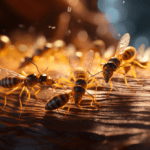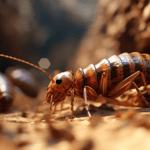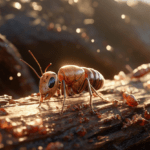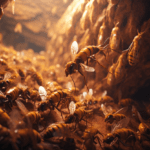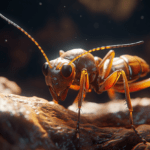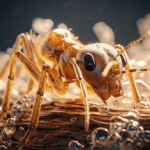Termites are silent intruders that can cause significant damage to your home if left untreated. Early detection is crucial in preventing extensive destruction. Understanding the signs of a termite infestation can help you take necessary action before it’s too late. In this article, we will explore the various indicators and steps you can take to tackle these unwelcome guests.
Note: Want to take proactive measures against termites? Don’t miss our guide on How to Prevent Termites from Eating Wood: Effective Strategies for Termite Prevention for essential tips.
How to Know If You Have a Termite Infestation
Identifying a termite infestation early is essential for effective pest control. By recognizing the signs, you can swiftly address the issue. Here are some key indicators to look out for:
- Hollowed Out Wood: One of the most common signs of a termite infestation is hollowed-out wood. These pests feed on cellulose, causing the wood to appear distorted or hollow. If you tap on the affected area and it sounds hollow, it’s likely termites are present.
- Droppings: Another telltale sign of termite activity is the presence of termite droppings, also known as frass. These tiny pellets resemble sawdust or coffee grounds and can be found near termite nests or damaged wood. Inspect your property regularly for these droppings as they indicate a nearby infestation.
- Discarded Wings: Reproductive termites, known as swarmers, shed their wings after finding a suitable location for a new colony. Spotting discarded wings around your windowsills, door frames, or near light fixtures is a strong indication of an active termite infestation.
- Mud Tubes: Termites construct mud tubes to move safely from their nests to their feeding sites. These thin, sheltered tunnels protect them from predators and provide moisture. Keep an eye out for these tubes along foundation walls, crawl spaces, or any other areas that make direct contact with the soil.
- Tight-Fitting Doors and Windows: As termites consume wood within your home, they can cause structural damage, leading to changes in your property’s alignment. Doors and windows may begin to stick or have difficulty opening and closing smoothly. This shift in alignment can be a sign of an underlying termite infestation.
- Blistered Wood: When termites consume wood, they leave behind moisture, which leads to blistered or warped surfaces. If you notice swollen or distorted areas on wooden structures, it’s likely that you have a termite problem.
What to Do if Termites Are Damaging Your Home
Discovering a termite infestation can be alarming, but swift action can help minimize the damage. Here’s what you can do if termites are damaging your home:
- Consult a Professional: It’s crucial to reach out to a licensed pest control expert who specializes in termite treatment. They have the knowledge, experience, and proper tools to accurately assess the extent of the infestation and develop an effective treatment plan.
- Termite Inspection: A thorough inspection will help determine the severity of the infestation and locate the termite colonies. Professional inspectors will identify the affected areas and provide recommendations for treatment.
- Treatment Options: Depending on the severity of the infestation, treatment options can vary. Common methods include liquid termiticides, termite baits, or fumigation. Your pest control expert will recommend the best approach based on your specific situation.
- Preventive Measures: After treating the infestation, it’s essential to take preventive measures to avoid future termite problems. Regular inspections, eliminating moisture sources, and sealing entry points are effective ways to protect your home.
Make Your Home Less Enticing to Termites
Prevention is key when it comes to termites. By making your home less inviting to these destructive insects, you can reduce the risk of infestation. Here are some preventive measures to consider:
- Eliminate Moisture: Termites are attracted to moisture, so it’s crucial to fix any leaks or plumbing issues promptly. Ensure proper drainage around your property and reduce excess moisture in crawl spaces.
- Remove Wood-to-Soil Contact: Minimize direct contact between soil and wooden structures by creating a barrier. Use concrete or metal supports to elevate wooden structures, such as porches or decks.
- Keep Firewood Away: Storing firewood near your home can provide easy access for termites. Maintain a reasonable distance between woodpiles and your house to discourage these pests from migrating.
- Regular Inspections: Schedule regular termite inspections with a professional pest control company. These inspections help detect early signs of termite activity and prevent major damage.
Signs of Termite Infestation: What to Look For
[youtube v=”oIu3Euu_cHM”]
Termites can be a homeowner’s worst nightmare, causing serious structural damage to your property. But how can you tell if you have a termite issue? In this article, we will discuss the visible signs of termites that you should be on the lookout for.
1. Mud Tubes
One of the most common signs of a termite infestation is the presence of mud tubes. These tubes are actually tunnels that termites create to protect themselves while they travel from their nest to your structure. You may notice these tubes along the slab or expansion joints of your home. If you spot any of these mud tubes, it’s a clear indication that termites are present and active.
2. Piles of Frass
Another visible sign of termites is the presence of little piles of frass. These frass may resemble wood pellets or sawdust. In reality, they are termite droppings. As termites tunnel and chew through wood, they kick out this frass. This is particularly common with dry wood termites. If you notice these piles of frass in your home, it’s a strong indication of a termite infestation.
3. Weak Wooden Floors and Damaged Wood
Termites can cause significant damage to the wood in your home. One way to identify their presence is by observing weak wooden floors or wood that appears hollowed out and damaged. As termites chew on the wood, they leave behind tunnels that they use to navigate undetected around your home. If you come across areas of weakened or damaged wood, you should consider it a red flag for a termite problem.
4. Swarming Termites
During certain times of the year, you may see swarming termites around your home. These swarmers are reproductive termites that are searching for a suitable spot to establish a new nest. Once they find a location, they shed their wings. So if you notice large piles of wings around window sills or entry points, it could indicate that termites are moving in and establishing a colony.
If you observe any of these signs of a termite infestation, it’s crucial to take immediate action to control the problem. Using high-quality pesticides specifically formulated for termites can help you eliminate the infestation and protect your property.
In conclusion, termites are a serious threat to homes and properties. By being vigilant and recognizing the visible signs of termite activity, you can take the necessary steps to address the infestation promptly.
For all your pest control questions and concerns, visit our website, call us, or stop by one of our stores. Our team at Solutions Pest and Lawn is here to assist you in resolving any pest-related problems you may encounter.
Conclusion
Detecting the signs of a termite infestation and taking immediate action is vital in protecting your home from extensive damage. The presence of hollowed-out wood, droppings, discarded wings, mud tubes, and tight-fitting doors and windows are red flags that should not be ignored. Consulting a professional and implementing preventive measures can help restore peace of mind and safeguard your most valuable investment.
FAQs
- Can termites cause structural damage to my home?
Termites can cause significant structural damage to homes if left untreated. They feed on cellulose, weakening wooden structures and compromising their integrity. - How can I differentiate termite droppings from other debris?
Termite droppings are small, pellet-like, and resemble sawdust or coffee grounds. They are often found near termite nests or damaged wood. - Are termite treatments safe for my family and pets?
Termite treatments, when administered by licensed professionals, are generally safe for your family and pets. However, it’s essential to follow any instructions given by the pest control company. - How often should I schedule termite inspections?
It is recommended to schedule termite inspections annually or as advised by a professional pest control company. Regular inspections help identify any signs of termite activity and enable early intervention. - Can I treat a termite infestation myself?
While there are do-it-yourself termite treatment options available, seeking professional assistance is recommended. Termites can be challenging to eradicate completely, and licensed experts have the expertise to ensure thorough treatment.
- Georgia Platform: A Southern Strategy, 1850s - March 31, 2025
- How many weeks is 40 days: Quick Conversion Guide for Accurate Results - March 31, 2025
- How many feet is 300 meters? 984 Feet: Understand Length Conversions Easily - March 31, 2025

